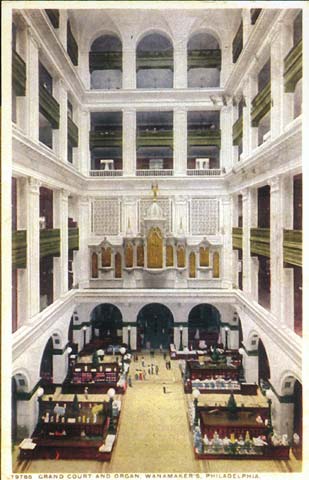| HOME | |
| WANAMAKER GRAND COURT
|
|
| SPECIFICATION | |
| AUDSLEY PROJECT | |
| DISCOGRAPHY | |
| VIDEOS | |
 |
|
| Rodman Wanamaker | |
|
Repères Historiques John Wanamaker (1838-1922), fut un grand homme de commerce. He opens his 1st store in 1861 in Philadelphie, the another in 1876. In 1896, he opens a store in New York, in which Austin install an organ 10 years later, IV/P (Austin opus 120, 1905, the original specification) that became the masterpiece of many attractions and concerts, this organ burn in a fire, then is rebuilt in the Wanamaker Organ Shop (12th floor of the Philly store), and destroyed in the 50's. During this time is being built the new store in Philadelphia. In 1908, Rodman Wanamaker, fascinated by the magnificence of the Grand Court conceived by his father has the idea of installing an organ ("I want the finest organ in the world"). Georges Washington Till (former associate of Wanamaker, worked at that time as organ builder, he has been the curator of the organ until 1938) is being charged to inspect the Festivall Hall organ, the one from the St-Louis World Fair 1904 in Louisiana. This instrument had been played by Guilmant (a serie of 40 recitals, twice a day), Lemare and many great names from the moment (more about : here). The organ arrives in Philadelphia in 1909. The new casework, which still hides the former case (photo), is conceived by the architect Daniel Hudson Burnham for the approximate amount of 10 000 $, il est garni de tuyaux réhaussé d'or 22 carats. The 1st public audition took place on june 22th 1911. The organ had 140 stops and 10059 pipes, opus 35 designed by George Ashdown Audsley for the 'Los Angeles Art Organ Company' which had bankrupted. At that time, it was the biggest organ in the world, but R. Wanamaker felt the volume was not sufficent for the immense Grand Court. Then will be built, in the store (Wanamaker Organ Shop), the future aditions to the organ under the direction of William Boone Fleming (who had also supervised the building of the original organ) : in 1914, 8000 more pipes, in 1917, a new 5-manual console with its coloured titling tablets to control the 232 stops. Other modifications has taken place from 1923 to 1930 (mixtures of Swell and Solo, new Orchestral and String divisions, new combination action, 6-manual console...) growing the instrument to 451 stops and 28500 pipes. Kimball & Co from Chicago and Gottfried & Co furnish metal pipes for some divisions. R.W. dies in 1928 without the pleasure to hear the final result of his work. See the Stentor page for the high-pressure division never-accomplished projects. The Wanamaker Organ has been, since then, of a great musical interest (Louis Vierne, Marco Enrico Bossi, Nadia Boulanger, Fernando Germani, Jeanne Demessieux, André Marchal, Pierre Cochereau...). A few events n°6 for organ and orchestra before 15000 people. Charles M. Courboin is the soloist, he gives a memorable rendition of Bach's Passacaglia, which inspires Stokowski for his famous transcription of the Toccata & Fugue in D minor (Walt Disney's Fantasia). Another concert is taking place on March 24 1920. redemptor omnium', 'Adeste fideles', 'Stabat mater dolorosa', 'Adoro te devote', this is the birth of his famous Symphonie-Passion. They are also taking part of the organ's enlargement. the enlargement that he will eventually never see, the dedication is cancelled. Stokowski (organ and orchestra version).
Les Organistes --
La Restauration -- |




